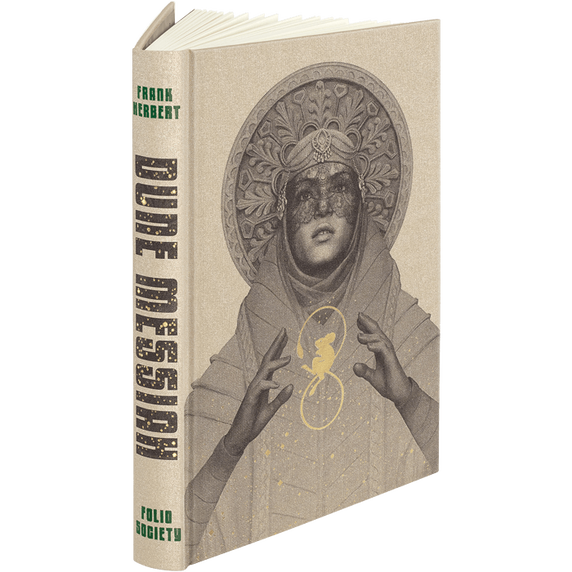
Discover the true scope of Frank Herbert’s vision in Dune: Messiah, the epic second act in the classic sci-fi saga, presented in a cinematic illustrated edition from The Folio Society.
Illustrated by Sam Weber
Introduced by Michael Dirda
Afterword by Brian Herbert
This collector’s edition of Frank Herbert’s phenomenal tale of far-future desert warriors, fallible messiahs and interplanetary intrigue is illustrated by award-winning artist Sam Weber, and published to celebrate the 50th anniversary of the world’s best-selling science-fiction title.
No more terrible disaster could befall your people than for them to fall into the hands of a Hero
Arrakis, or Dune, is a planet of nothingness – its torched wastelands are home to a fierce nomadic people, and under the endless deserts stalk gargantuan sandworms the size of starships. It is a place where water is sacred – ‘a substance more precious than all others’ – where to shed a tear is the most taboo of all sacrifices. And yet the planet is also humanity’s sole source of ‘spice’, the mysterious, addictive substance that underpins the workings of the galaxy-wide Padishah Empire. To control Arrakis is to control all. And it is across its vast expanses and in its arid caves that Frank Herbert’s epic adventure of political subterfuge and messianic deliverance is played out, a story that has become the best-selling science-fiction novel of all time, and is considered by many to be the genre’s greatest work.
Winner of a D&AD Design awards 2016 Wood Pencil
Bound in printed and blocked metallic buckram
Set in Dante with Helvetica Neue and Black Tulip display
576 pages
Frontispiece, 11 colour illustrations and 10 black & white chapter headings
Endpaper map by Martin Sanders
Printed slipcase
10˝ x 6¾˝
Original appendices included as follows; also includes the ‘Terminology of the Imperium’:
Appendix I: The Ecology of Dune
Appendix II: The Religion of Dune
Appendix III: Report on Bene Gesserit Motives and Purposes
Appendix IV: The Almanak en-Ashraf
‘Great book!’
- Frank Skinner
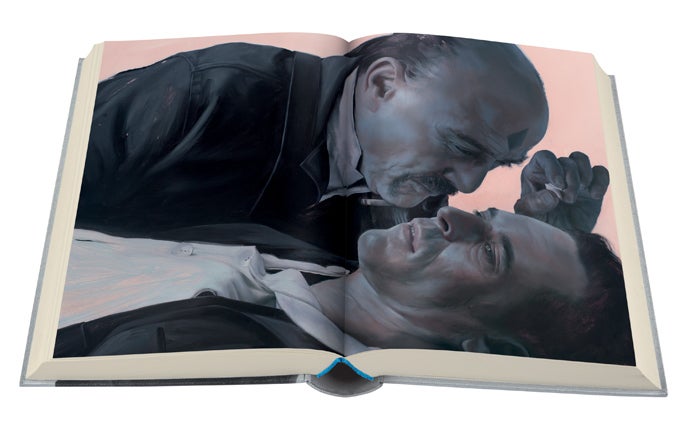
The far-future universe created by Herbert is nothing short of a phenomenon. After the novel’s publication in 1965, it won both the Hugo and Nebula awards, going on to sell over 12 million copies, and spawning five sequels, as well as multiple board games, computer games, television series and feature films. It is a universe of ‘traps within traps’, of human computers, secretive witch-cults and fanatic warriors, all with their own intricate histories and intentions. Humanity has resorted to a delicately balanced feudal system of governance, each aristocratic family struggling for survival, competing for control of a decadent empire. However, despite the grand scale of Herbert’s fully formed universe, at its heart Dune is the story of a single boy, Paul Atreides, who finds himself caught in the web of a myth, centuries in the making. Is he the fabled Kwisatz Haderach, able to span time – ‘who can be many places at once’? Betrayed and exiled into the waterless deserts of Arrakis, his destiny will not only be fulfilled, but the future of humankind decided, and from the dunes will arise a saviour – Muad’Dib – both terrible and beautiful in his absolute power.
In the construction of Dune Herbert drew on a range of influences, both literary and scientific, from the origin stories of the Abrahamic desert religions and T. E. Lawrence’s Bedouin desert revolt to cutting-edge terraforming techniques and the burgeoning environmentalist movement. For this edition, Pulitzer Prize-winning critic Michael Dirda has contributed a new introduction, examining both the origins of Herbert’s unlikely success and the hidden depths of his ‘grand operatic vision’. On the surface it is a classic adventure story – a boy coming of age to reclaim his birthright – but soon Herbert strikes a darker vein, exploring the terrors of prescribed destiny and the problematic notion of hero-making. As the chosen ‘one’ emerges, we discover his role has little to do with goodness; the quakes of fanatical jihad – like the desert’s giant sandworms – rumble under the surface, waiting to swallow the galaxy one planet at a time. It is a compelling dissection of literature’s, and humanity’s, mania with the godlike ‘hero’. As Paul’s friends become worshippers and his family become idols, the thin line between god, liberator and oppressor is increasingly indistinct.
‘Dune seems to me unique among SF novels in the depth of characterisation and the extraordinary detail of the world it creates. I know nothing comparable to it except The Lord of the Rings ’
- Arthur C. Clarke

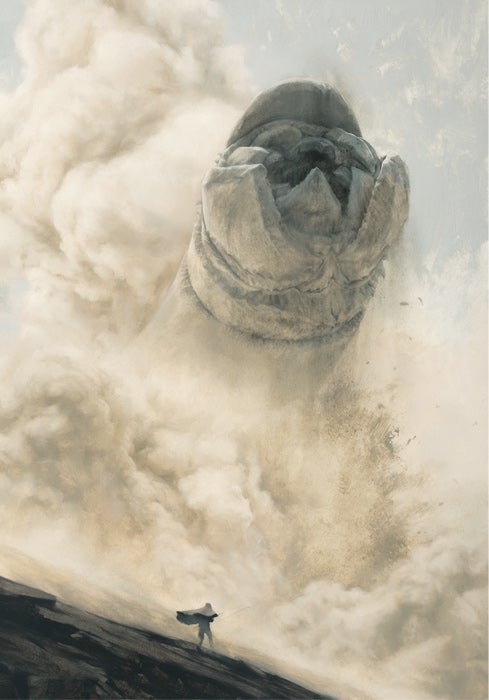
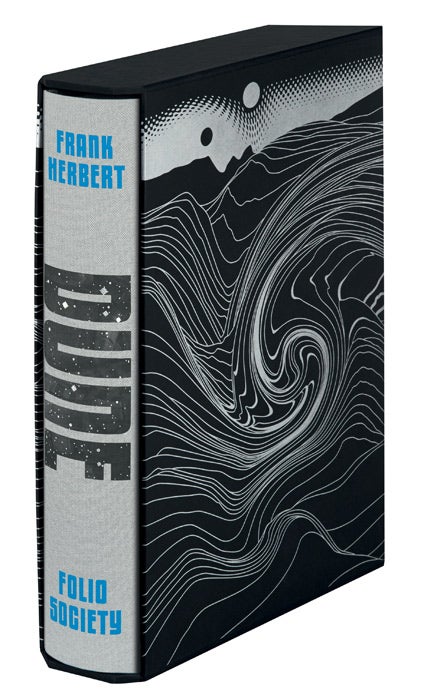
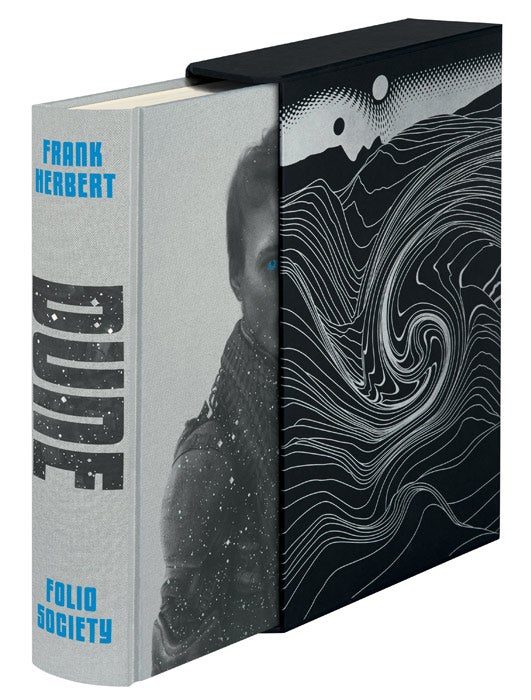
‘Congratulations to Sam and The Folio Society on creating a stunning, evocative new take on one of science fiction’s greatest novels’
- Tor.com
The meticulously constructed characters and ecology of Dune have become enshrined in science-fiction folklore, from the grotesque, bloated mass of the evil Baron Harkonnen to the towering sandworms, breaching the mountainous dunes. This much anticipated edition is illustrated by Sam Weber, whose work also appears in the acclaimed Folio editions of Fahrenheit 451 and Lord of the Flies. His acutely detailed illustrations perfectly capture the intricacies of Herbert’s vision, realising the faces and landscapes of Arrakis as never before. Also included is an illuminating afterword by Brian Herbert, son of the author, who has penned several best-selling novels that expand the Dune universe. The pictorial slipcase reproduces the undulating landscape of Arrakis, while the binding design depicts Paul Atreides, his body shrouded in a veil of stars, grain-like in their multitude. His eyes are blocked in the unforgettable ‘blue within blue’, consumed by both the spice and his ‘terrible purpose’.
‘If you’ve never read Dune, this handsome Folio Society edition, enhanced by the haunting artwork of Sam Weber, will introduce you to one of modern literature’s most exciting and unforgettable books’
- Michael Dirda
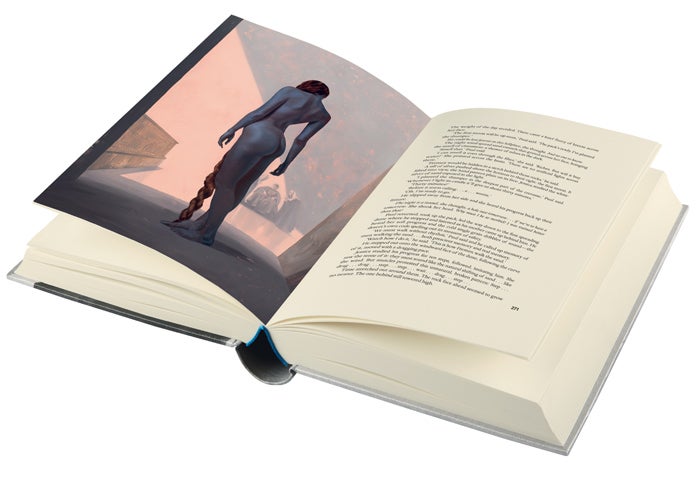
Even now, half a century since it first appeared in 1965, Dune is certainly still ‘the one’ – it continues to top readers’ polls as the greatest science-fiction novel of modern times. Many would say of all time. Before Star Wars, before A Game of Thrones, Frank Herbert brought to blazing life a feudalistic future of relentless political intrigue and insidious treachery, a grandly operatic vision – half-Wagner, half-spaghetti western – of a hero discovering his destiny. Characters include elite samurai-like warriors, sadistically decadent aristocrats, mystical revolutionaries, and, not least, those monster worms, which barrel along under the desert surface with the speed of a freight train, then suddenly emerge from the sand like Moby Dick rising from the depths.
Once settled on Arrakis, Duke Leto hopes to bring a more humane government to this forlorn planet. He initially sends his master at arms, Duncan Idaho, to form an alliance with the native Fremen, who, encased in still suits that recycle all their body fluids, can survive in seemingly impossible conditions. Others in Leto’s close circle of advisors include the logical, Mr Spock-like ‘Mentat’ and assassin Thufir Hawat, the troubadour swordmaster Gurney Halleck, and the sensitive Dr Wellington Yueh. However, Baron Harkonnen – one of the most repulsive villains in literature – has plans of his own for the Atreides household. To escape Harkonnen traps-within-traps, Lady Jessica and Paul must eventually flee into the desert, where they will gradually discover what her son calls his ‘terrible purpose’.
Like David Lean’s film Lawrence of Arabia – the modern work of art Dune most resembles – Herbert’s novel exhibits epic sweep while remaining, at heart, the intensely moving story of a young man caught up in a myth. To become a hero, let alone a messiah, is to cut oneself off from all others; to watch friends sink into worshipers; to loose forces that may be impossible to control; ultimately, after sowing the wind, to reap the whirlwind.
Frank Herbert was born in Tacoma, Washington, in 1920. He took his first newspaper job at the age of 19. After serving in the US Navy as a photographer, he studied briefly at the University of Washington. His first science-fiction story, ‘Looking for Something’, was published in the pulp-science-fiction magazine Startling Stories (1952), and his first novel, The Dragon in the Sea (1956) was serialised soon afterwards. In 1959 he began work on his most famous work, Dune, which was serialised by Analog magazine between 1963 and 1965. Finally published as a book, with modifications, in 1965 (Folio 2015), Dune won the inaugural Nebula Award for Best Novel and the Hugo Award in 1966, and Herbert went on to write five popular sequels. Herbert wrote for a number of newspapers, including the Seattle Post-Intelligencer, lectured at the University of Washington, and served as an ecological consultant in Vietnam and Pakistan. He published many other science-fiction novels, such as his WorShip series and the ConSentient novels, but Dune, which was made into a film in 1984 (two years before Herbert’s death), and into a television series in 2000, remains his most enduring work.
Sam Weber was born in Alaska, and grew up in Deep River, Ontario, Canada. After attending the Alberta College of Art and Design in Calgary, Sam moved to New York to pursue illustration and attend graduate school at The School of Visual Arts. His work for The Folio Society includes Lord of the Flies (2009) and Fahrenheit 451 (2011). His illustrations for Dune were painted in oil on board, with the black-and-white chapter headings in ink and charcoal on paper.
Michael Dirda is a Pulitzer Prize-winning literary journalist, a weekly books columnist for the Washington Post, and the author of five collections of essays: Readings (2000), Bound to Please (2005), Book by Book (2006), Classics for Pleasure (2007) and Browsings (2015). He has also written the memoir An Open Book (2003) and On Conan Doyle (2012), which received an Edgar Allan Poe Award from the Mystery Writers of America. His current project is a reconsideration of popular fiction during the late nineteenth and early twentieth centuries. He has written introductions to The Great Gatsby (2013), Dune (2016), East of Eden (2017) and Atlas Shrugged (2018) for The Folio Society.
Brian Herbert was born in Seattle, Washington, in 1947, the elder son of Frank Herbert. His biography of his father, Dreamer of Dune: The Biography of Frank Herbert (2003), was a finalist for the Hugo Award. Keeping alive the fantasy world which Herbert Snr created, he has collaborated with Kevin J. Anderson on numerous prequels and sequels to the Dune novels, which have regularly featured on the New York Times best-seller list. His other novels include Sidney’s Comet (1983), Sudanna, Sudanna (1986), Man of Two Worlds (1986, co-authored with Frank Herbert), The Race for God (1990), and Ocean (2013), which he co-authored with his wife, Jan Herbert.
